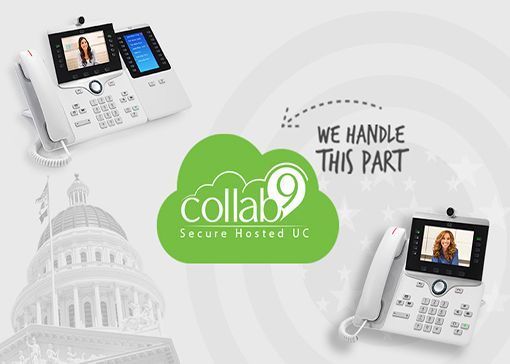Collab9 Shares Insights for Making a Smooth, Seamless Switch to UCaaS

More and more businesses are upgrading their communications systems by using Unified Communications as a Service (UCaaS)--and the benefits of utilizing collaboration and communication applications on an IP network are helping businesses work smarter and faster. However, like any other business investment, moving from a legacy system to a UCaaS solution is a major endeavor. Not only will the switch affect how your teams communicate, it will also have a significant impact on operations in the long-term. That is why it is vital for companies planning to make the switch to ensure that the transition goes as smooth and as seamless as possible. But how?
Steven Boberski, Vice President for Business Development at collab9, offers some insights for businesses looking to take advantage of a UCaaS solution and shares with VoipReview.org how collab9’s UCaaS solution can help companies looking to meet and overcome modern business challenges.
Why Make the Transition to UCaaS

It’s hard to deny the immense impact the cloud has had on business communications. According to Boberski, the communications industry revolution and evolution all began with the cloud. “If you’ve been in the industry long enough, you remember the original cloud: Centrex service delivering digital features across copper wires. Consumers loved the simple recurring charges per month, but these systems afforded little flexibility. Then along came the PBX, which evolved into VoIP and IP phones,” said Boberski.
VoIP (Voice over Internet Protocol) technology changed the game and showed businesses that it was possible to make and receive calls over the internet at a fraction of the cost of a traditional landline. The evolution of communication capabilities, however, did not end there. Because IP telephony is digital and cloud-based, innovators realized that it was also possible to combine VoIP with other forms of digital communications (such as email, SMS, video, and conferencing) to create a complete communications suite. So Unified Communications (UC) was an easy, natural fit for the business communications industry. UC integrates real-time enterprise communication services with non-real-time communication services. To avoid the capital and operational expenses of deploying a UC solution on their own, many companies decide to use Unified Communications as a Service (UCaaS). UCaaS is a UC delivery model in which communication and collaboration services are delivered through a third-party service provider over the internet or other IP networks.
UCaaS (or cloud-based UC) is growing in popularity because it provides so many benefits to enterprises. For starters, it gives businesses the advantage of scaling their service on an on-need basis. “Traditionally, companies paid up front for PBX licensing and maintenance fees for the entire organization, regardless of the number of users or even what features were enabled,” explained Boberski. "With the cloud organizations have access to evergreen technology without having to pay for upgrades and recurring maintenance, which is much easier for company budgeting exercises. The Cloud Service Provider (CSP) now owns the upgrading and maintenance of your system. With UCaaS, SMBs and enterprises can easily move up or down between service tiers, enabling or disabling features on demand,” he added.
Another major advantage of transitioning to a cloud-based UC, says Boberski, is provisioning. Users have the option to retain direct limited control over the service, but they no longer own the equipment. They can also deploy the solution faster, and have far more dedicated resources. “When you own and operate a premises solution, you may not have the resources to train or implement a solution. Many organizations subsequently become locked in an endless upgrade cycle," explained Boberski. "Adoption is hindered not only by the required skill set but also by the time it takes to deploy." The advantage of the cloud is that you don't have to own anything; instead, you can leverage a multi-tenant infrastructure to select the most applicable solutions or tools.
Given the benefits of UCaaS, making the decision to move to a cloud-based UC solution should be an easy decision for companies to make. The hard part, though, is ensuring a successful transition from legacy systems to UCaaS.
Critical Steps Companies Should Take When Moving into the Cloud
UCaaS implementations can be challenging. To achieve optimum outcomes, Boberski advises companies to consider the following:
- Focus on one’s business requirements first- “When moving to a cloud solution, people get wrapped around the the concept of the feature parity,” said Boberski. “This is when the concept of transformation (rather than transition) becomes relevant. Ask: 'what does the business require?' instead of 'what technology does it need?' This will lead you down the path to developing business requirements. Only then can you take the next step.”
- Consider the functional requirements - According to Boberski, businesses should address what their system does rather than how it does it. They should skirt the idea of doing a like-to-like feature comparison. “Many organizations fail to properly identify functional requirements, opting instead to duplicate the current feature set in its entirety," said Boberski. "This approach does the organization a disservice. My advice is to start with a blank slate. Now is the time to identify what your solution needs to do tomorrow, rather than how the legacy system is configured today.”
- Technical requirements come last - Boberski suggests that businesses should first focus on what their business requirements are, then derive their functional requirements, which only then allows them to establish technical requirements. “You will find that you will have a better experience and will create a solution you need instead of trying to wedge legacy features into a modern Unified Communications system," said Boberski. "It allows you to develop a far more effective solution.”
Solving Modern Business Challenges with collab9’s UCaaS Solution
Collab9, a FedRAMP Authorized Unified Communications as a Service (UCaaS) provider, offers a secure hosted Unified Communications solution for organizations looking to keep up with today’s ever-changing business landscape. Collab9’s UCaaS combines voice, video, web conferencing, messaging, mobility, and customer care into a predictable, per user per month subscription-based model.
 With collab9’s hosted UC, organizations can take advantage of the following:
With collab9’s hosted UC, organizations can take advantage of the following:
- Cost savings
- Geographically redundant centers
- Integration with cloud-based email
- Increased productivity
- BYOD/Mobility
- Employee Safety/Emergency response
In addition to offering their services to businesses, collab9 also caters to the secure communication needs of federal, state, and local government agencies. “We take the 'best of breed' approach to secure cloud Unified Communications, and for us to do that and serve the federal government, it means FedRAMP compliance," explained Boberski. "We need this in order to offer cloud services to federal agencies, as they require hundreds of controls; for example: a system-wide requirement for encryption of data at rest and in motion, and support for multi-factor authentication. When we introduce something in that is FedRAMP accredited, it means it has gone through an entire [security] audit.”
Collab9 recently partnered with AVST to develop and deploy a joint cloud-based UC solution for federal, state and local government entities. “AVST offers the best in class industry for transcription, voicemail, UC, messaging, and interoperability," shared Boberski. "This helps with government agencies who use Microsoft and Skype for Business. Everyone is using Skype for Business out of the box, and through a soft client like this we can deliver additional capabilities like IVR and voicemail."
Learn more about collab9 and how the company's secure, hosted UC is empowering today’s organizations by visiting collab9’s website.
About Collab9
collab9 was America’s first FedRAMP Authorized Service Provider of Unified Communications, catering to federal, state, and local government with infrastructure that meets NIST 800-53 security requirements. This user-based subscription model integrates voice, video, and web conferencing, messaging, mobility and customer care services.
Headquartered outside of Los Angeles, collab9 provides hosted UC in a secure space through their channel partners.




